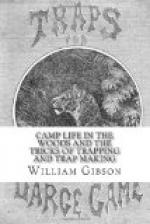THE NET TRAP.
The lion and tiger are often taken in a net, which is secured to a frame work and suspended over a tempting bait. When the latter is touched the net falls, and the victim becomes entangled in the meshes and is securely caught. So far as we know, this mode of capture is never tried in this country. For the puma, lynx and wild-cat we fancy it might work admirably. The net should be of stout cord, and should be secured to a heavy square frame work, tilted as in the coop trap, already described. There should be plenty of slack in the net, and the looseness should be drawn flat over the framework in folds. The contrivance may be set by a large figure four trap, page (107), or the device described under the coop trap, page (67).
The use of bird lime, for the capture of a tiger, certainly seems odd; but it is, nevertheless, a common mode of taking the animal, in the countries where this marauder abounds. The viscid, tenacious preparation known as bird lime is described on page (97) and is familiar to most of our readers. For the capture of birds it is unfailing, when once their delicate plumage comes in contact with it. Its effect on the tiger is surprising, and many a hunter has secured his striped foe by its aid. For this purpose, the cans of the preparation are arranged on elevated boards around a bed of leaves, in which the bait is placed. A small platform is so placed that the tiger shall step upon it in reaching for the bait, which, by the aid of strings, tilts the boards and tips off the cans. The lime spills on its victim and over the bed of leaves, and the tiger, in his endeavors to free himself from the sticky substance only succeeds in spreading it, and as he rolls and tumbles on the ground he soon becomes completely smeared and covered with the dry leaves, from which it is impossible for him to extricate himself.
In his frantic rage he writhes upon the ground and becomes an easy [Page 36] prey to the hunter, who is generally on hand for the fray.
Steel traps are much used for the capture of large game, and are made in sizes especially adapted for the purpose. These are described under the proper head, in another portion of this work; and the various baits and modes of setting required for the different animals, are clearly set forth under their respective titles of the latter, in the section “Art of Trapping.”




